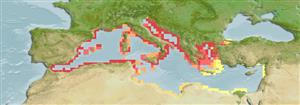Common names from other countries
>
Gobiiformes (Gobies) >
Gobiidae (Gobies) > Gobionellinae
Etymology: Pomatoschistus: Greek, poma, -atos = cover, operculum + Greek, schistos = divided (Ref. 45335).
Environment: milieu / climate zone / depth range / distribution range
Écologie
marin; saumâtre démersal; profondeur 7 - 14 m (Ref. 92840). Subtropical; 46°N - 30°N, 6°W - 36°E
Mediterranean Sea: eastward into the Sea of Marmara.
Taille / Poids / Âge
Maturity: Lm ? range ? - ? cm
Max length : 3.0 cm TL mâle / non sexé; (Ref. )
Description synthétique
Clés d'identification | Morphologie | Morphométrie
Pectoral fin with 14-16 rays; males with several short bars on flank, mostly on lower half; females with 3-4 short bars on flank, mostly on lower half (Ref. 59043); body shape is terete, slightly depressed; eyes situated dorso-laterally; reduced swim bladders (Ref. 92840).
Found on sand and gravel in 7 m (Ref. 4696, 92840), muddy sand bottom in 10 m and rock sand ecotone in 14 m; meiofauna feeder; live together with G.geniporus, prefers benthic prey as well as fish and suprabenthic like harticoids and ostracods. (Ref. 92840). Max. length (Robert A. Patzner, pers. comm., 1999).
Life cycle and mating behavior
Maturities | Reproduction | Spawnings | Egg(s) | Fecundities | Larves
Miller, P.J., 1986. Gobiidae. p. 1019-1085. In P.J.P. Whitehead, M.-L. Bauchot, J.-C. Hureau, J. Nielsen and E. Tortonese (eds.) Fishes of the North-eastern Atlantic and the Mediterranean. Volume 3. UNESCO, Paris. (Ref. 4696)
Statut dans la liste rouge de l'IUCN (Ref. 130435)
CITES (Ref. 128078)
Not Evaluated
Menace pour l'homme
Harmless
Utilisations par l'homme
Outils
Articles particuliers
Télécharger en XML
Sources Internet
Estimates based on models
Preferred temperature (Ref.
115969): 17.5 - 19.8, mean 18.9 (based on 311 cells).
Phylogenetic diversity index (Ref.
82804): PD
50 = 0.5001 [Uniqueness, from 0.5 = low to 2.0 = high].
Bayesian length-weight: a=0.00692 (0.00295 - 0.01623), b=3.05 (2.87 - 3.23), in cm Total Length, based on LWR estimates for this Genus-body shape (Ref.
93245).
Niveau trophique (Ref.
69278): 3.3 ±0.34 se; based on food items.
Résilience (Ref.
120179): Milieu, temps minimum de doublement de population : 1,4 à 4,4 années (Assuming fec < 10,000).
Fishing Vulnerability (Ref.
59153): Low vulnerability (10 of 100).
